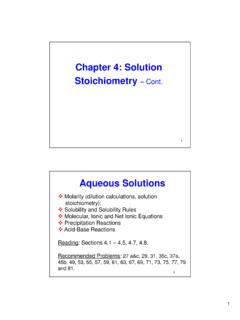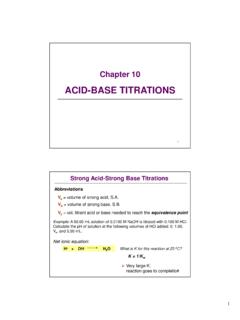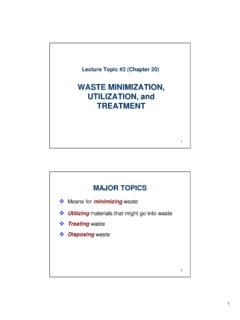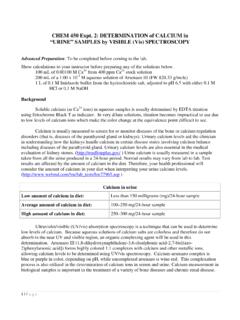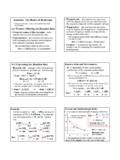Transcription of Chapter 4: Chemical and Solution Stoichiometry
1 1 Chapter 4: Chemical and Solution Stoichiometry (Sections )1 Reaction Stoichiometry The coefficients in a balanced Chemical equation specify the relative amounts in moles of each of the substances involved in the reaction2 C4H10 (g)+ 13 O2 (g) 8 CO2 (g) + 10 H2O (g)Tro: Chemistry: A Molecular Approach, 2/eMole ratio2mol C4H10: 13mol O2: 8mol CO2: 10mol H2O 2 molecules of C4H10react with 13 molecules of O2to form 8 molecules of CO2and 10 molecules of H2O 2 moles of C4H10react with 13 moles of O2to form 8 moles of CO2and 10 moles of H2O22 Predicting Amounts from Stoichiometry The amount of any other substance in a Chemical reaction can be determined from the amount of justonesubstanceTro: Chemistry: A Molecular Approach, 2/e2C4H10 (g)+ 13 O2 (g) 8CO2 (g)+ 10 H2O (g)102424108 moles CO2 22 moles C H x88 momoles C Hles CO= How much CO2 can be made from moles of C4H10in the combustion reaction of C4H10?
2 3 Practice According to the following equation, how many moles of water are made in the combustion of moles of glucose?C6H12O6+ 6 O2 6 CO2+ 6 H2 OTro: Chemistry: A Molecular Approach, 2/eAnswer: mol H2O43 Stoichiometryand Chemical ReactionsThe most common stoichiometric problem will present you with a certain mass of a reactant and then ask the amount or mass of productthat can be formed. This is called mass-to-massstoichiometry problem5 Predicting Amounts from Stoichiometry You cannot convert mass (g) of one substance directly to mass (g) of another substance in a given reaction. What if the mass of a substance is given, how do we know how much of another substance is needed (reactant) or is produced (product)?2. However, you can convert mass to moles, then use their mole ratio to convert moles to grams of another Amounts from Stoichiometry Mass-Mass Chemical equation.
3 2. Convert the known massof reactant to molesusing MM as a conversion factor. 3. Use the mole or stoichiometric ratio of reactant to product to convert moles of reactant to moles of Finally, use the MM of the product to convert its moles to mass. Goal: To calculate the mass of product(s) given the mass of a reactant85 Example: Estimate the mass of CO2produced in 2007 by the combustion of x 1015g gasoline. Assuming that gasoline is octane, C8H18, the equation for the reaction is2 C8H18 (l)+ 25 O2 (g) 16 CO2 (g)+ 18 H2O (g) Follow the process:g C8H18mol CO2g CO2mol C8H18 Tro: Chemistry: A Molecular Approach, 2/eSolving Mass-Mass Stoichiometry MMUse mole ratio in balanced equationUse MM9 Example: Estimate the mass of CO2produced in 2007 by the combustion of x 1015g x 1015g C8H18g CO2 Conceptual Plan:Relationships:Given:Find:g C8H18mol CO2g CO2mol C8H18 Tro: Chemistry: A Molecular Approach, 2/e2C8H18 (l) + 25 O2 (g) 16CO2 (g)+ 18 H2O (g)1 mol C8H18= ;1 mol CO2= , 2 mol C8H18:16 mol CO2106 Solution := x 1013 mol C8H18g C8H18mol CO2g CO2mol x 1013 mol C8H18= x 1014 mol x 1014 mol CO2= x 1016 g CO211MM C8H18= MM CO2= 2 mol C8H18:16 mol CO2 (fr.)
4 The balanced eq n) x 1015g C8H18g CO2 Solution :Conceptual Plan:Relationships:Given:Find:g C8H18mol CO2g CO2mol C8H18 Tro: Chemistry: A Molecular Approach, 2/eAlternate Solution : One step with multiple conversion factors127 Your turn:(1) How many grams of chlorine gas can be liberated from the decomposition of g of AuCl3by the reaction:2 AuCl3 (s) 2 Au(s) + 3 Cl2 (g)Answer: g Cl2 Stoichiometry AuCl3mol Cl2g Cl2mol AuCl3 Relationships:331 mol g AuCl233 mol Cl2 mol g Cl1 mol Cl13 Limiting reactant, theoretical yield, and percent yieldTro: Chemistry: A Molecular Approach, 2/e148 In real life, we don t use the exact mole ratio of reactants as shown in the balanced equation Limiting Reactant and Theoretical Yield In practice, an excess of one reactant is used for two reasons: (1) To drive the reaction to completion(2) To maximize the yield of products The reactant that is added in excess amount is called the excess reactant, while the one in lower or limiting amount is called the limiting reactantor limiting Reactant and Theoretical Yield -Cont.
5 The max. amount of product that can form when all of the limiting reactant is used up is called the theoretical yield. Calculating theoretical yield:1. Calculate yield assuming the first reactant is Calculate yield assuming the 2nd reactant is limiting. 3. Choose the smaller of the two amounts. The reactant that produces the smaller yieldis the limiting reactantNOTE: The limiting reactantis: (1) completely consumed in a Chemical reaction. Thus, it (2) determines (or limits) the amount of product Theoretical Yield g of aluminum and g of sulfur are combined to form aluminum sulfide according to the equation:Al(s)+ S (s) Al2S3 (s)Determine the limiting reactant and calculate the theoretical yield in grams of vs. Actual (1) Not all the reactants may react (2) Presence of significant side reactions (3) Physical recovery of 100% of the sample may be impossible - like getting all the peanut butter out of the jar The amount of product actually obtainedis called the actual yield < Theoretical yieldWHY?
6 To calculate percent yield:% yield=actual yieldtheoretical yieldx 1001810 More Mass-Mass Stoichiometry example: Limiting reactant calculation: Consider the reaction: 2Al + 3I2------> 2 AlI3aluminum iodinealuminum iodideDetermine the limiting reagent and the theoretical yield of the product if one starts with: a) mol Al and mol ) g Al and g iodinec) How many grams of Al are left over in part b? Solution : a) Moles (instead of grams) are given so we use them mole theoretical mole ratio (fr. the balanced eq.) and compare it with the actual ratio (given) to find the limiting + 3I2 ------> 2 AlI3 Obviously, 489 g is less than 652, so Al is the limiting reagent (lower yield from Al), making I2the excess reagent20a) Calculate yield of AlI3from mol Al and mol Al = ; MM I2= and MM AlI3= g/molAssume Al is limiting:3333 mol g mol Al xx mol Al1 m428ol9 AlIg 2 AlI1 =3333 mol g mol I xx mol I1 m23652 g AloIl AlI22 =Now assume I2is limiting:112Al + 3I2------> 2 AlI3 Solution Cont.
7 (b) Determine the yield of the AlI3if one starts with g Aland g mol I mol g g I xx g I 23mol I21 AlI g AlI =MM Al = ; MM I2= and MM AlI3= g/molWORK:(i) Calc. yield of the AlI3assuming Al is limiting(ii) Calc. yield of the AlI3assuming I2is limiting3333 mol g AlI1 mol g Al g Al mol Al1 mol g l22A II x =22(iii) Pick the lower of two yields because it came from the limiting reactant. This is the theoretical yield of : limiting reactant is I2and theoretical yieldof AlI3is g12 More Mass-Mass Stoichiometry HOMEWORK problem: A g sample of ammonia is mixed with g of (g) + O2 (g) NO (g) + H2O (g)Which is the limiting reactant? How much NO is produced? First, balance the equation:NH3 (g) + O2 (g) NO (g) + H2O (g)Next we can use Stoichiometry to calculate how much NOproduct is produced by each reactant.
8 NOTE: It does not matter which product is chosen, but the same product must be used for both reactants so that the amounts can be O2from NH3 The reactant that produces the lesser amount of product, in this case the oxygen, is thelimiting reactant. 244NH3 (g) + 5O2 (g) 4NO (g) + 6H2O (g)Given: g
